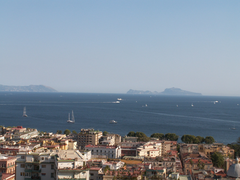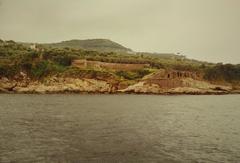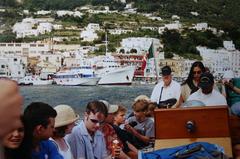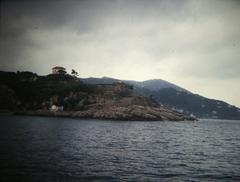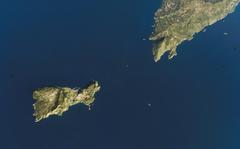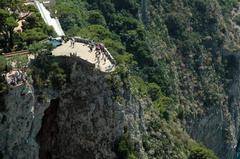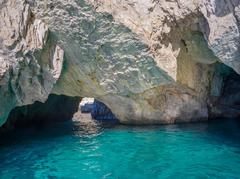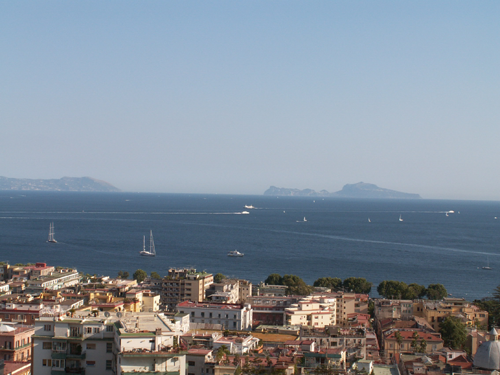
Visiting The Blue Cave in Capri: A Comprehensive Guide
Date: 18/07/2024
Introduction to The Blue Cave
The Blue Grotto, or Grotta Azzurra as it is locally known, is a captivating sea cave situated along the northwestern coast of Capri, Italy. This natural wonder is celebrated for its ethereal blue light, a mesmerizing phenomenon that draws thousands of visitors each year. Historically, the Blue Grotto’s allure can be traced back to the Roman era, where it served as a sanctuary and a site of reverence. Rediscovered in the 19th century, its stunning blue waters and rich cultural significance have made it one of Capri’s most visited attractions.
Table of Contents
- Introduction
- A Shimmering Past - Unveiling the History of the Blue Grotto
- Visitor Information
- Nearby Attractions
- Special Events and Guided Tours
- Photographic Spots
- The Geological Origins of the Blue Grotto
- The Unique Blue Light Phenomenon
- Environmental Concerns and Conservation Efforts
- Tourism and Economic Impact
- Challenges and Sustainability
- FAQ
- Conclusion
A Shimmering Past - Unveiling the History of the Blue Grotto
The Blue Grotto, a mesmerizing sea cave nestled along the northwestern coast of Capri, has captivated hearts for centuries. Its story is a blend of myth, history, and natural wonder, adding a layer of depth to its already enchanting beauty.
Roman Whispers - An Ancient Sanctuary
The Blue Grotto’s history stretches back to the Roman era, with evidence suggesting its use as a…
Visitor Information
Blue Grotto Visiting Hours
The Blue Grotto is generally open to visitors from 9:00 AM to 5:00 PM, but hours can vary based on sea conditions. It’s best to check local updates before planning your visit.
Blue Grotto Tickets
Tickets for the Blue Grotto can be purchased on-site or online. Prices typically range from €14 to €18, depending on the season. Consider booking in advance during peak tourist periods to ensure availability.
Accessibility
The Blue Grotto is accessible by boat, with regular departures from Marina Grande in Capri. Note that the entrance to the cave is low, requiring visitors to lie flat in the boat for entry.
Travel Tips
- Arrive early to avoid the crowds.
- Wear comfortable clothing and bring sunscreen.
- Check the weather and sea conditions before planning your visit.
Nearby Attractions
While in Capri, explore other historical sites such as Villa Jovis and the Gardens of Augustus. These attractions offer a deeper dive into the rich history and stunning landscapes of Capri.
Special Events and Guided Tours
Throughout the year, special events and guided tours are available, providing unique experiences and insights into the Blue Grotto’s history and natural beauty.
Photographic Spots
Capture the Blue Grotto’s enchanting blue light and stunning views. The best times for photography are early morning and late afternoon when the light is most vibrant.
The Geological Origins of the Blue Grotto
The Blue Grotto, like other sea caves around the world, owes its existence to the relentless forces of nature, specifically the erosive power of the sea. Over millennia, the crashing waves of the Tyrrhenian Sea, driven by winds and currents, carved their way into the limestone cliffs of Capri.
Limestone, being a relatively soft rock, is particularly susceptible to this kind of erosion. The constant pounding of the waves creates cracks and fissures in the rock, which gradually widen over time. The process is aided by the chemical weathering of the limestone. Rainwater, slightly acidic due to dissolved carbon dioxide, reacts with the calcium carbonate in limestone, further dissolving the rock and enlarging the cavities.
The Unique Blue Light Phenomenon
The Blue Grotto’s claim to fame is undoubtedly its ethereal blue light. This mesmerizing spectacle is not the result of artificial lighting or pigments in the water. Instead, it is a fascinating interplay of sunlight and the cave’s unique underwater structure.
Sunlight enters the grotto through a small submerged opening located just below the main entrance. As light passes through this underwater opening, the water filters out most of the red end of the light spectrum. Red light has longer wavelengths and is absorbed more readily by water. In contrast, blue light, with its shorter wavelengths, is scattered and reflected, giving the grotto its characteristic glow.
The intensity and hue of the blue light vary depending on the time of day and weather conditions. The most vibrant blue is typically observed around midday when the sun is at its zenith, allowing the maximum amount of light to penetrate the cave.
Environmental Concerns and Conservation Efforts
The Blue Grotto, while a breathtaking natural wonder, is also a fragile environment susceptible to various threats. The increasing influx of tourists, coupled with the impacts of climate change, poses significant challenges to the cave’s preservation.
Pollution from Boat Traffic
One of the primary concerns is the pollution from boat traffic. The exhaust fumes from motorboats release pollutants into the air and water, which can harm marine life and degrade the water quality within the grotto. The constant churning of the water by boat propellers also stirs up sediment, reducing water clarity and potentially damaging the cave’s delicate ecosystem.
Impact of Climate Change
Climate change further exacerbates these issues. Rising sea levels, a consequence of global warming, threaten to submerge the cave’s entrance, making it inaccessible. Additionally, ocean acidification, caused by the absorption of excess carbon dioxide from the atmosphere, can dissolve the limestone walls of the grotto, weakening its structure.
Conservation Measures
Recognizing these threats, authorities have implemented several measures to protect the Blue Grotto. These include:
- Restricting boat access: Only authorized rowboats are allowed inside the grotto, and the number of boats permitted at any given time is strictly regulated.
- Promoting sustainable tourism: Efforts are underway to educate tourists about the cave’s fragility and encourage responsible behavior, such as avoiding littering and minimizing noise pollution.
- Monitoring and research: Ongoing scientific monitoring helps assess the cave’s health and guide conservation strategies. Researchers study the water quality, marine life, and the impact of tourism to develop effective preservation measures.
Tourism and Economic Impact
The Blue Grotto holds immense economic significance for Capri and the surrounding Campania region. Its ethereal beauty and historical allure attract a considerable influx of tourists, making it a cornerstone of the local economy.
Tourism Revenue
The Blue Grotto is one of Italy’s most popular tourist attractions, drawing hundreds of thousands of visitors annually. The revenue generated from entrance fees to the grotto contributes significantly to the local government’s budget. This income is reinvested in the maintenance and preservation of the grotto, as well as in other tourism infrastructure on the island.
Employment Opportunities
The thriving tourism industry centered around the Blue Grotto creates numerous job opportunities for the local population. These jobs are diverse, ranging from boat operators who ferry tourists to the grotto entrance to tour guides, souvenir vendors, and staff at nearby restaurants and hotels. This employment contributes to the economic well-being of Capri’s residents and helps sustain local businesses.
Multiplier Effect
The economic impact of the Blue Grotto extends beyond direct tourism revenue and employment. The influx of tourists generates a multiplier effect, stimulating economic activity in various sectors. Tourists spend money on accommodation, dining, transportation, and souvenirs, benefiting hotels, restaurants, transportation providers, and local artisans. This ripple effect contributes to the overall economic growth of Capri and the Campania region.
FAQ
Q: What is the best time to visit the Blue Grotto?
A: The best time to visit is early in the morning to avoid crowds and enjoy the best lighting.
Q: How do I get tickets for the Blue Grotto?
A: Tickets can be purchased on-site or online. It’s advisable to book in advance, especially during the peak season.
Q: Is the Blue Grotto accessible for people with disabilities?
A: The entrance to the Blue Grotto is narrow and requires visitors to lie flat in the boat, which may pose challenges for individuals with mobility issues.
Conclusion
The Blue Grotto stands as a beacon of natural beauty, historical significance, and economic vitality. Its enchanting blue light has captivated hearts for centuries, making it a must-visit destination for tourists from around the world. The cave’s rich history, dating back to Roman times, adds a layer of depth to its already mesmerizing allure. The Blue Grotto’s unique geological features and the interplay of sunlight create a visual spectacle that is both fascinating and scientifically intriguing.
However, with great popularity comes the responsibility of preservation. The increasing influx of tourists and the impacts of climate change present significant challenges. Efforts to manage tourism sustainably and protect the grotto’s delicate ecosystem are crucial for its continued allure. The economic benefits derived from the Blue Grotto are substantial, contributing to local employment and stimulating economic activity in various sectors. By implementing sustainable tourism practices and conservation measures, the local community aims to ensure that future generations can continue to marvel at this natural wonder while reaping its economic benefits.
